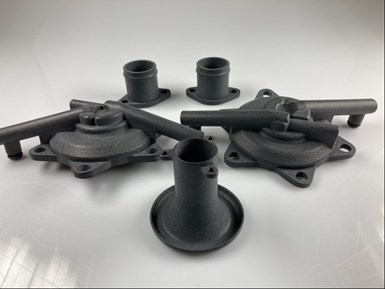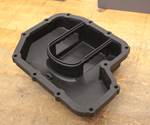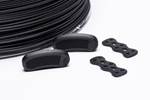Evonik, Lehvoss launch fiber-reinforced polyamide for SLS
Collaboratively, Lehvoss has developed Luvosint PA613 9711 CF, which is capable of being processed via standard laser sintering machines.

Laser-sintered components made from Luvosint PA613 9711 CF. Photo credit: Lehvoss
In cooperation with Evonik (Marl, Germany), Lehvoss (Hamburg, Germany) has developed a PA613 with compounded carbon fiber reinforcement — Luvosint PA613 9711 CF. The base polymer PA613 was designed by Evonik specifically for laser sintering. It is characterized by low moisture absorption, high temperature stability and — unlike PA6 — high process stability in laser sintering. The fiber reinforcement consists of high-strength XCF fibers, which have previously been used in Luvocom XCF products for injection molding. When it comes to powder production, approaches to particle technology were taken in order to preserve the fiber lengths in the individual particles as best as possible.
Powder bed processes, such as laser sintering, offer geometric freedom when printing components, which is necessary because the components originally designed for injection molding have complex geometries. Unfortunately, reinforced polymers in powder form are a contradiction. Fibers mixed dry into plastic powders can make do, but unbound, very thin fibers or mineral microscopically thin needles can be risky to handle from an occupational safety perspective. For this reason, they do not receive internal approval from industrial 3D printing processors.
Printing the Luvosint PA613 9711 CF requires a build chamber temperature of 195°C, which makes standard laser sintering machines suitable for processing. The material absorbs the wavelengths of CO2, diode or fiber lasers.
“The fact that the first automotive OEMs have already qualified for spare parts production shows that we are on the right track,” says Dr. Marcus Rechberger, product manager for Luvosint at the Lehvoss Group. “Nevertheless, in laser sintering, there still needs to be a lot of willingness to innovate in order to develop even more industrially relevant material — including machines optimized for this — in order to bring industrial 3D printing into ‘series.’”
Related Content
-
Low-cost, efficient CFRP anisogrid lattice structures
CIRA uses patented parallel winding, dry fiber, silicone tooling and resin infusion to cut labor for lightweight, heavily loaded space applications.
-
Otto Aviation launches Phantom 3500 business jet with all-composite airframe from Leonardo
Promising 60% less fuel burn and 90% less emissions using SAF, the super-laminar flow design with windowless fuselage will be built using RTM in Florida facility with certification slated for 2030.
-
Plant tour: Airbus, Illescas, Spain
Airbus’ Illescas facility, featuring highly automated composites processes for the A350 lower wing cover and one-piece Section 19 fuselage barrels, works toward production ramp-ups and next-generation aircraft.












